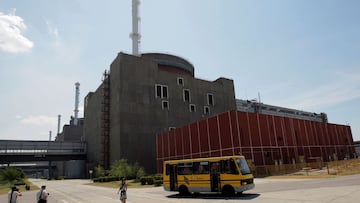Why do we need nuclear power plants?
Russia's attack on the Zaporizhzhia nuclear plant - and the fire it caused - has underlined the dangers of nuclear energy. But it's a power source that can help solve our carbon-emissions problem.


As humanity attempts to limit global warming and, with it, the adverse effects of climate change, nuclear power has a role to play in providing a sustainable, low-carbon energy source.
Despite its advantages, however, nuclear energy comes with catastrophic consequences when power production goes wrong. Such dangers were again highlighted on Friday, when a Russian attack on the Zaporizhzhia nuclear power plant in Ukraine led to a fire at the facility, which is the largest of its kind in Europe.
More:
- American veterans fighting Russia in Ukraine
- Vladimir Putin lookalike: the innocent man scared for his life
- Republican senators criticised for potentially endangering President Zelesnkyy
How does nuclear energy work?
In the 1930s, scientists discovered that an atom of a specific type of uranium - uranium-235 - could have its nucleus split into two by bombarding it with neutrons, which are particles that make up the nuclei of atoms. When a uranium-235 atom is split, this releases energy in the form of heat and radiation. This process is called nuclear fission.
As well as generating energy, splitting a uranium-235 atom also releases more neutrons. These neutrons can then hit other surrounding uranium-235 atoms, giving off further energy and yet more neutrons, which themselves split atoms around them. What has been created is a chain reaction of nuclear fission that is at the heart of nuclear power production.
At nuclear power plants, this chain reaction takes place under controlled conditions in what’s called a reactor core. The heat from the energy generated inside the core is used to convert water into steam, which in turn serves to rotate a turbine that produces electricity.
A stable energy source that's low in carbon emissions
As part of the Paris Climate Accord, 191 nations have committed to limiting the rise in average global temperatures to no more than 2ºC above pre-industrial levels. Since that agreement was signed in 2015, however, experts have said we really need to aim for 1.5ºC if we’re to minimise the most severe effects of climate change. To do so, worldwide carbon emissions need to drop by 45% on their 2010 levels by 2030, and to net zero by 2050.
Given that nuclear power plants produce low carbon emissions, supporters of nuclear energy see a key future role for the power source alongside other sustainable sources such as wind and solar energy. A trait that particularly appears to work in the favour of nuclear power, which currently provides around 10% of the world’s electricity, is its stability of production. The US’ Office of Nuclear Energy refers to nuclear power as “America’s workhorse”, noting that the country’s 55 plants operated at maximum capacity 93% of the time in 2020. In comparison, wind and solar production was at full power for 35.4% and 24.9% of the year, respectively.
“Nuclear is steady,” argues Rebecca Casper, the mayor of US city Idaho Falls, which has a long history of nuclear power production. Speaking to the International Atomic Energy Agency (IAEA), Casper declared: “It allows for that marriage between all of the different carbon-free sources. It’s the key that makes all of that other desirable alternative energy possible, because alone it just can’t sustain a growing population.”
Safety issues the chief disadvantage of nuclear power
Fuelled by notorious past accidents at nuclear power plants, there are legitimate concerns about the danger posed by the radiation given off in the fission process. This radiation is kept from contaminating the environment around it by concrete containment structures built around the nuclear reactor, but disasters such as those that occurred in Chernobyl in 1986 and Fukushima in 2011 have shown that these protective shells can be breached.
The accidents in Chernobyl and Fukushima both occurred when the uranium in the reactor core was allowed to overheat, causing the core to melt down. This led to explosions that released large amounts of radiation into the surrounding atmosphere.
In the case of Chernobyl, this radiation has contaminated some 150,000 square kilometres of Belarus, Russia and Ukraine, stretching as far as 500 kilometres from the accident site, the IAEA says. While the number of deaths as an immediate result of the disaster was 31, the World Health Organization (WHO) has estimated that there could end up being as many as 4,000 fatalities in the long term, among Russians, Belarusians and Ukrainians who, for example, contract cancer or leukaemia due to the effects of exposure to radiation. Radioactive fallout from Chernobyl was also carried across much of the northern hemisphere, the IAEA adds, but "the amounts dispersed were in many instances insignificant".
Japanese authorities’ quicker response to the Fukushima accident means radiation contamination was far more significantly contained, but estimations of the potential long-term death toll have nonetheless reached as high as 1,000.
After fire broke out at Zaporizhzhia, before later being extinguished, Ukrainian President Vlodymyr Zelenskyy spoke of his fear that a blast at the plant could lead to “the death of Europe”. “If there will be an explosion, it will be the end to all of us, the end of Europe, the evacuation of Europe,” Zelenskyy said.
Nuclear terrorism requires decisive action in response. At the #UN Security Council meeting, we called for closing the sky over 🇺🇦 and launching an operation to maintain peace and security. The goal is to save hazardous facilities. The world must not watch, but help!
— Володимир Зеленський (@ZelenskyyUa) March 4, 2022
A further safety issue in the generation of nuclear energy is the disposal of the highly radioactive and toxic waste it creates. In the US, there is still no permanent nuclear waste repository; as things stand, it is generally stored in underground casks on the site of nuclear power plants.
High costs of nuclear power make it less competitive
Related stories
The cost of nuclear power production is also a disadvantage. This starts with the expense of building nuclear plants, which is much higher than for energy such as coal and natural gas, for example. According to the Bulletin of the Atomic Scientists, “this is because nuclear power plants are technically complex and must satisfy strict licensing and design requirements. The design and construction of a new nuclear power plant requires many highly qualified specialists and often takes many years, compounding financing costs, which can become significant.”
Once built, the costs of running a nuclear power point are also high, says the US Office of Nuclear Energy: “Challenging market conditions have left the nuclear industry struggling to compete. Strict regulations on maintenance, staffing levels, operator training, and plant inspections have become a financial burden for the industry.”

